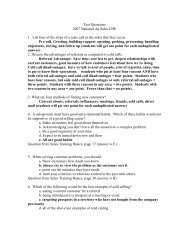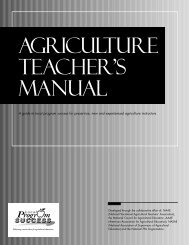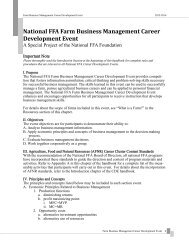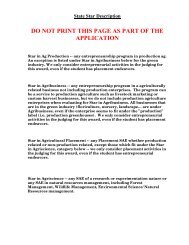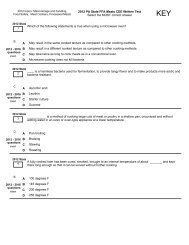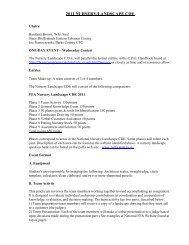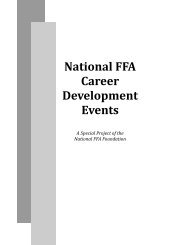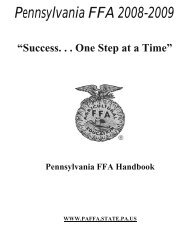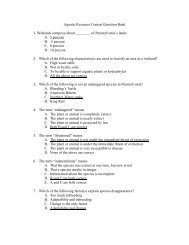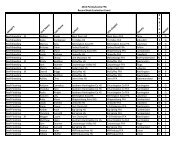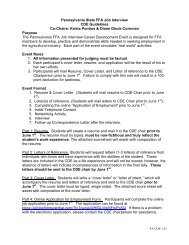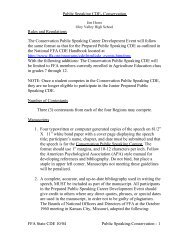wildlife cde this is a 2-day event - Pa FFA
wildlife cde this is a 2-day event - Pa FFA
wildlife cde this is a 2-day event - Pa FFA
- No tags were found...
Create successful ePaper yourself
Turn your PDF publications into a flip-book with our unique Google optimized e-Paper software.
WILDLIFE CDETHIS IS A 2-DAY EVENTRon WeanerDoverSteve KlineWest SnyderTues<strong>day</strong>On-campus classroom--bring #2 pencilIdentification of 20 species in each of two groups: (A) birds, (b) mammals, plus identification of(C) 10 bird calls and habitat management (<strong>Pa</strong>rt IV). There will be a 50-question <strong>wildlife</strong> test.Wednes<strong>day</strong>State Game Lands--bring pencil and clipboard and dress for the weather.Identification of (A) <strong>wildlife</strong> foods, (B) <strong>wildlife</strong> signs, (C) animal tracks, and (D) habitat siteevaluation.<strong>Pa</strong>rt I -- Identification of Species and Bird Calls60 pointsBirds 20 species 20 pointsMammals 20 species 20 pointsBird calls 10 species 20 pointsSilhouettes, mounted specimens, pictures, and color slides may be used. Bird call suggestedreference: Peterson Field Guides - Eastern/Central Bird Songs, Axia - Know Your CommonBirdsongs<strong>Pa</strong>rt II -- Wildlife Test50 pointsTh<strong>is</strong> part includes 50 comprehensive questions on <strong>wildlife</strong> conservation and management.Suggested references are:1. PA Game Comm<strong>is</strong>sion “Wildlife Note Series”2. PA Game Comm<strong>is</strong>sion “A Digest of Hunting & Trapping Regulations”3. PA Game Comm<strong>is</strong>sion “Mammals of Pennsylvania”4. PA Game Comm<strong>is</strong>sion “Birds of Pennsylvania”5. PA Game Comm<strong>is</strong>sion website6. Textbook - Delmar “Wildlife and Natural Resource Management”<strong>Pa</strong>rt III -- Identification60 pointsWildlife Foods 10 species 20 pointsReferences: (1) Invite Birds to Your Home - Conservation Plantings for the Northeast, SoilConservation Service; (2) Shrubs and Vines for Northeastern Wildlife, U. S. Forest Service;(3) Peterson Field Guide to Trees and Shrubs; (4) The Audubon Society, Field Guide to NorthAmerican Trees - Eastern Region.Wildlife Signs 10 species 20 pointsStudents will identify furs, hair, feathers, scat, gnarlings, and rubbings, etc.Wildlife Tracks 10 species 20 points<strong>FFA</strong> State CDE - 12/02 Wildlife - 1
References: (1) PGC - Mammals of PA; (2) Nasco Field Guide to Tracks of North AmericanWildlife; (3) Peterson Field Guide to Animal Tracks; (4) Guide to Mammals of PA by JosephMerritt; (5) Tracking and the Art of Seeing by <strong>Pa</strong>ul Rezendes.<strong>Pa</strong>rt IV -- Environmental Analys<strong>is</strong> Evaluation20 pointsHabitat evaluation involves determining which species of <strong>wildlife</strong> are best suited to a particularhabitat. v<strong>is</strong>ual aids, field observations, and worksheets may be included in <strong>th<strong>is</strong></strong> part of the CDE.The criteria for selecting the species which are best suited to a particular habitat should reflectthe food, shelter, water, and living space available to the animal at <strong>th<strong>is</strong></strong> site.ReminderContestants should bring a #2 pencil to both <strong>day</strong>s of the contest. Wednes<strong>day</strong>’s part of thecontest will be held outside, so please dress accordingly and bring a clipboard.<strong>FFA</strong> State CDE - 12/02 Wildlife - 2
WILDLIFE CDEMASTER SCORE SHEETNameSchool<strong>Pa</strong>rt I -- Identification:TotalA. Birds 20B. Mammals 20C. Bird calls 20Total 60<strong>Pa</strong>rt II -- Wildlife Test 50<strong>Pa</strong>rt III -- IdentificationA. Foods 20B. Signs 20C. Tracks 20Total 60<strong>Pa</strong>rt IV -- Environmental Analys<strong>is</strong> Evaluation 20____FINAL SCORE 190<strong>FFA</strong> State CDE - 12/02 Wildlife - 3
Environmental Analys<strong>is</strong> ScorecardName ________________________________________________ Team No. ___________Chapter ______________________________________________ Member No. _________Question1. Identify and l<strong>is</strong>t as many organ<strong>is</strong>ms (both native and invader)that can be found within t he marked boundaries of <strong>th<strong>is</strong></strong> site.PossiblePoints4Score2. Identify and l<strong>is</strong>t all non-living components found within themarked site.43. Describe the food web presented in <strong>th<strong>is</strong></strong> marked ecosystem.44. Identify the stages of succession of various grasses, shrubs,and trees.45. Determine whether a healthy balance ex<strong>is</strong>ts and recommendremediation where needed.4Total Score 20<strong>FFA</strong> State CDE - 12/02 Wildlife - 4
NameSchool<strong>Pa</strong>rt I -- Species Identification -- BIRDSPlace the number of the species from the master l<strong>is</strong>t on <strong>th<strong>is</strong></strong> page next to the number of the slidethat identifies that species._____ 1_____ 2_____ 3_____ 4_____ 5_____ 6_____ 7_____ 8_____ 9_____ 10_____ 11_____ 12_____ 13_____ 14_____ 15_____ 16_____ 17_____ 18_____ 19_____ 20WATERFOWL1. American Black Duck2. American Wigeon3. Blue-winged Teal4. Bufflehead5. Canada Goose6. Canvasback7. Common Goldeneye8. Common Merganser9. Green-winged Teal10. Hooded Merganser11. Lesser Scaup12. Mallard13. Northern Pintail14. Northern Shoveler15. Old Squaw16. Red-breasted Merganser17. Redhead18. Ring-necked Duck19. Ruddy Duck20. Tundra Swan21. White-winged Scoter22. Wood DuckBIRDS OF PREY23. American Kestrel24. Bald Eagle25. Barn Owl26. Barred Owl27. Broad-winged Hawk28. Coopers Hawk29. Golden Eagle30. Great Horned Owl31. Long-eared Owl32. Merlin33. Northern Goshawk34. Northern Harrier35. Osprey36. Peregrine Falcon37. Red-shouldered Hawk38. Red-tailed Hawk39. Saw-whet Owl40. Screech Owl41. Sharp-shinned Hawk42. Short-eared Owl43. Snowy Owl44. Turkey VultureWINTER BIRDS45. American Crow46. Black-capped Chickadee47. Blue Jay48. Brown Creeper49. Dark-eyed Junco50. Downy Woodpecker51. Evening Grosbeak52. Golden-crowned Kinglet53. Hairy Woodpecker54. Homed Lark55. House Sparrow56. Northern Cardinal57. Northern Shrike58. Pileated Woodpecker59. Pine Grosbeak60. Pine S<strong>is</strong>kin61. Purple Finch62. Red-breasted Nuthatch63. Red Crossbill64. Redpoll65. Ruby-crowned Kinglet66. Snow Bunting67. Starling68. Tree Sparrow69. Tufted Titmouse70. White-breasted Nuthatch71. White-throated Sparrow72. White-winged CrossbillBIRDS OF FIELD AND GARDEN73. American Goldfinch74. American Robin75. Barn Swallow76. Bobolink77. Bobwhite78. Brown Thrasher79. Chimney Swift80. Chipping Sparrow81. Common Flicker82. Common Grackle83. Common Yellowthroat84. Eastern Bluebird85. Eastern Kingbird86. Eastern Phoebe87. Eastern Meadowlark88. Field Sparrow89. Gray Catbird90. House Wren91. Indigo Bunting92. Killdeer93. Mourning Dove94. Northern Mockingbird95. Purple Martin96. Ring-necked Pheasant97. Ruby-throated Hummingbird98. Song Sparrow99. Yellow-billed Cuckoo100. Yellow-breasted Chat101. Yellow WarblerMARSH & WATER BIRDS102. American Bittern103. American Coot104. Belted Kingf<strong>is</strong>her105. Black-crowned Night Heron106. Common Snipe107. Great Blue Heron108. Great Egret109. Green Heron110. Herring Gull111. Horned Grebe112. King Rail113. Lesser Yellowlegs114. Marsh Wren115. Pied-billed Grebe116. Red-winged Blackbird117. Ring-billed Gull118. Solitary Sandpiper119. Sora120. Spotted Sandpiper121. Tree SwallowBIRDS OF THE FOREST122. American Redstart123. American Woodcock124. Black & White Warbler125. Black-throated Blue Warbler126. Black-throated Green Warble127. Cedar Waxwing128. Cerulean Warbler129. Chestnut-sided Warbler130. Great-Crested Flycatcher131. Hermit Thrush132. Hooded Warbler133. Kentucky Warbler134. Magnolia Warbler135. Northern Raven136. Ovenbird137. Red-eyed Vireo138. Red-headed Woodpecker139. Rose-breasted Grosbeak140. Ruffed Grouse141. Rufous-sided Towhee142. Scarlet Tanager143. Veery144. Wild Turkey145. Wood Thrush146. Yellow-rumped Warbler<strong>FFA</strong> State CDE - 12/02 Wildlife - 6
NameSchool<strong>Pa</strong>rt I -- Species Identification -- MAMMALSPlace the number of the species from the master l<strong>is</strong>t on <strong>th<strong>is</strong></strong> page next to the number of the slidethat identifies that species._____ 1_____ 2_____ 3_____ 4_____ 5_____ 6_____ 7_____ 8_____ 9_____ 10_____ 11_____ 12_____ 13_____ 14_____ 15_____ 16_____ 17_____ 18_____ 19_____ 201. Beaver2. Big Brown Bat3. Black Bear4. Bobcat5. Coyote6. Eastern Chipmunk7. Eastern Cottontail Rabbit8. Eastern Mole9. Eastern Woodrat10. Elk11. Flying Squirrel12. Fox Squirrel13. Gray Fox14. Gray Squirrel15. Long-tailed Weasel16. Meadow Vole17. Mink18. Muskrat19. Northern Short-tailed Shrew20. Nutria21. Porcupine22. Raccoon23. Red Fox24. Red Squirrel25. River Otter26. Snowshoe Hare27. Striped Skunk28. Virginia Opossum29. White-footed Mouse30. White-tailed Deer31. Woodchuck<strong>FFA</strong> State CDE - 12/02 Wildlife - 7
NameSchool<strong>Pa</strong>rt I -- Species Identification -- BIRD CALLSPlace the number from <strong>th<strong>is</strong></strong> l<strong>is</strong>t of birds in the space next to the number that corresponds withthe bird call played for you._____ 1_____ 2_____ 3_____ 4_____ 5_____ 6_____ 7_____ 8_____ 9_____ 10_____ 11_____ 12_____ 13_____ 14_____ 15_____ 16_____ 17_____ 18_____ 19_____ 201. American Robin2. American Bittern3. American Woodcock4. American Crow5. American Redstart6. Barred Owl7. Black-capped Chickadee8. Black-crowned Night-Heron9. Blue Jay10. Bobolink11. Bobwhite12. Brown Thrasher13. Brown-headed Cowbird14. Canada Goose15. Cedar Waxwing16. Chimney Swift17. Common Grackle18. Dark-eyed Junco19. Eastern Meadowlark20. Eastern Kingbird21. Eastern Bluebird22. European Starling23. Gray Catbird24. Great Homed Owl25. Hooded Warbler26. House Wren27. House Finch28. House Sparrow29. Killdeer30. Mourning Dove31. Northern Cardinal32. Northern Flicker33. Northern Oriole34. Northern Mockingbird35. Northern Cardinal36. Ovenbird37. Pileated Woodpecker38. Red-eyed Vireo39. Red-tailed Hawk40. Red-winged Blackbird41. Ring-necked Pheasant42. Rose-breasted Grosbeak43. Ruffed Grouse44. Rufous-sided Towhee45. Scarlet Tanager46. Screech Owl47. Song Sparrow48. Whip-poor-will49. White-throated Sparrow50. Wood Thrush<strong>FFA</strong> State CDE - 12/02 Wildlife - 8
NameSchool<strong>Pa</strong>rt III -- Identification -- FOODSExamine each food carefully. Place the number from the l<strong>is</strong>t of foods in the space next to thenumber that corresponds with the ten samples you are shown._____ 1_____ 2_____ 3_____ 4_____ 5_____ 6_____ 7_____ 8_____ 9_____ 101. American Beech2. American Chestnut3. American Elderberry4. American Holly5. American Honeysuckle6. American Mountain-ash7. Arrowwood8. Autumn-olive9. Bigtooth Aspen10. Bittersweet---both nativeand introduced11. Blackberry12. Black Cherry13. Black Locust14. Black Oak15. Black Raspberry16. Black Walnut17. Buckwheat18. Butternut19. Buttonbush20. Common Persimmon21. Common Spicebush22. Coralberry23. Crabapple24. Dogwood--both nativeand introduced25. Greenbrier26. Hackberry27. Hercules-club28. Juneberry29. Mapleleaf Viburnum30. Mimosa Tree31. Mulberry32. Multiflora Rose33. Nannyberry34. Northern Red Oak35. Osage-orange36. <strong>Pa</strong>wpaw37. Pignut Hickory38. Pin Oak39. Po<strong>is</strong>on Ivy40. Quaking Aspen41. Red Maple42. Shagbark Hickory43. Shellbark Hickory44. Smooth Sumac45. Staghorn Sumac46. Sunflower47. Tartarian Honeysuckle48. Teaberry49. Virginia Creeper50. Washington Hawthorn51. White Oak52. Wild Grape<strong>FFA</strong> State CDE - 12/02 Wildlife - 9
NameSchool<strong>Pa</strong>rt III -- Identification -- WILDLIFE SIGNSExamine each exhibit carefully. Place the number from the l<strong>is</strong>t of birds and animals in the spacenext to the number that corresponds with the ten samples you are shown._____ 1_____ 2_____ 3_____ 4_____ 5_____ 6_____ 7_____ 8_____ 9_____ 101. American Black Duck2. American Crow3. American Kestrel4. American Woodcock5. Beaver6. Black Bear7. Blue Jay8. Blue-winged Teal9. Bobcat10. Bobwhite11. Canada Goose12. Common Grackle13. Common Flicker14. Common Snipe15. Coyote16. Eastern Cottontail Rabbit17. Elk18. Fox Squirrel19. Gray Fox20. Gray Squirrel21. Great Blue Heron22. Great Horned Own23. Green-winged Teal24. House Sparrow25. Killdeer26. Long-tailed Weasel27. Mallard28. Meadow Vole29. Mink30. Mourning Dove31. Muskrat32. Northern Cardinal33. Porcupine34. Raccoon35. Red Fox36. Red-tailed Hawk37. Red-winged Blackbird38. Ring-necked Pheasant39. River Otter40. Ruffed Grouse41. Screech Owl42. Snowshoe Hare43. Starling44. Striped Skunk45. Tundra Swan46. Virginia Opossum47. White-tailed Deer48. Wild Turkey49. Woodchuck50. Wood Duck<strong>FFA</strong> State CDE - 12/02 Wildlife - 10
NameSchool<strong>Pa</strong>rt III -- Identification -- TRACKSExamine each exhibit carefully. Place the number from the l<strong>is</strong>t of birds and animals in the spacenext to the number that corresponds with the ten samples you are shown._____ 1_____ 2_____ 3_____ 4_____ 5_____ 6_____ 7_____ 8_____ 9_____ 101. American Coot2. American Crow3. Bald Eagle4. Beaver5. Black Bear6. Bobcat7. Bobwhite8. Canada Goose9. Common Flicker10. Common Snipe11. Coyote12. Dark-eyed Junco13. Domestic Cat14. Domestic Dog15. Downy Woodpecker16. Eastern Chipmunk17. Eastern Cottontail Rabbit18. Eastern Woodrat19. Elk20. F<strong>is</strong>her21. Fox Squirrel22. Gray Fox23. Gray Squirrel24. Great Blue Heron25. Green-winged Teal26. Long-tailed Weasel27. Mallard28. Meadow Jumping Mouse29. Meadow Vole30. Mink31. Muskrat32. Northern Short-tailed Shrew33. Norway Rat34. Pileated Woodpecker35. Porcupine36. Raccoon37. Red Fox38. Red Squirrel39. Ring-necked Pheasant40. River Otter41. Ruffed Grouse42. Snowshoe Hare43. Spotted Sandpiper44. Striped Skunk45. Virginia Opossum46. White-footed Mouse47. White-tailed Deer48. Wild Turkey49. Woodchuck50. Wood Duck<strong>FFA</strong> State CDE - 12/02 Wildlife - 11



